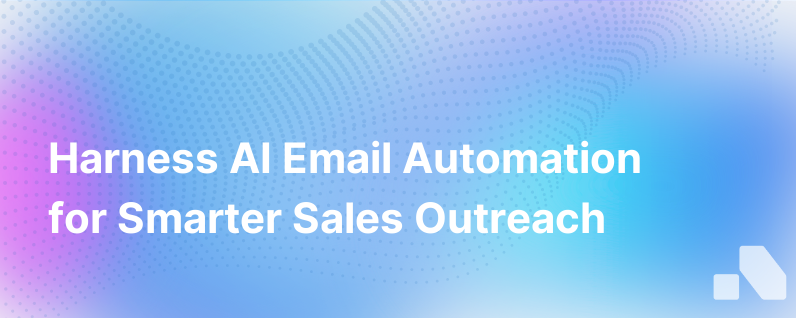
In today's hyper-connected world, email remains a cornerstone of business communication. Yet, as inboxes overflow and attention spans shrink, sending impactful emails has become increasingly challenging. This is where AI email automation comes in, as the knight in shining armor for modern marketers and sales professionals.
AI email automation is not your traditional set-it-and-forget-it email scheduling. It's smarter, more intuitive, and incredibly personalized. With AI-driven insights and triggers, emails don't just reach inboxes; they engage minds and prompt actions.
Below, we'll explore the nuances of smarter AI email automation—how it is a game-changer for business communication, the features that set it apart, and how to integrate it into your marketing stack effectively.
What Makes AI Email Automation Intelligent?
Unlike standard automation that operates on the basic logic of "if this, then that" triggers, AI email automation learns and adapts. The sheer amount of data AI can process empowers it to draft more personalized messages, time sends for when users are most likely to engage, and continuously optimize for better results.
Here are some qualities that differentiate smarter AI email automation:
Personalization at Scale: AI algorithms can analyze user data to craft highly tailored content. It's no longer about just using a recipient's first name. Now it's about sending emails that resonate with their past behavior, preferences, and even the tone they're most likely to respond positively to.
Predictive Send Times: AI tools can predict when a recipient is most likely to open an email based on historical data. This maximizes the likelihood of your emails being read and acted upon rather than getting buried under new messages.
Advanced Segmentation: Effective segmentation ensures that you're speaking directly to each audience's needs and interests. AI can automatically segment your audience based on a variety of factors, often in real-time, to tailor your messaging effectively.
Optimized Subject Lines and Copy: AI can test and determine which subject lines and body copy versions work best, sometimes tweaking copy on the fly to resonate with particular segments.
Behavioral Trigger Emails: Advanced AI algorithms can trigger emails based on nuanced behaviors such as website interaction patterns, purchase history, or even sentiment analysis from previous communications.
A/B and Multivariate Testing: AI layers predictive analytics onto traditional A/B testing, expediting the learning curve and allowing for nuanced testing of multiple variables simultaneously.
Journey Mapping: AI maps customer journeys through your ecosystem, triggering emails at critical touchpoints to guide prospects further down the sales funnel or to enhance customer experience post-purchase.
Spam Score Monitoring: AI monitors email elements that could trigger spam filters, tweaking messages before they're sent to ensure they reach their intended inboxes.
Effective Strategies for AI Email Automation
To tap into the power of smarter AI email automation, businesses need to approach it with a strategy that focuses on both technology and content.
1. Data Is King: Start with clean, high-quality data. AI can only work as well as the information fed into it. The saying "Garbage in, garbage out" is particularly pertinent here—ensuring that your user data is accurate and up-to-date is crucial.
2. Content Is Still Queen: Even with all the technical wizardry AI offers, content remains pivotal. Quality, relevant, engaging content is what will set your emails apart and make AI tools worthwhile.
3. Consistent Testing and Optimization: Use the AI's ability to run continuous tests to consistently improve emails. The optimization process should be ongoing to adapt to changing user behaviors and preferences.
4. Privacy and Data Compliance: Ensure that your AI email automation aligns with GDPR, CCPA, and other data protection laws. Transparency in data use and email practices builds trust with your customers.
5. Training and Onboarding: Educate your team on using AI email automation. The more adept they are at understanding the tool's insights, the better they will deploy it.
6. Leverage Multichannel Insights: Combine insights from multiple touchpoints to inform the AI's decisions. A holistic view strengthens the personalization and accuracy of your emails.
7. Monitor AI Decisions: Machine learning isn't infallible. Regularly review the AI's choices to ensure they align with your brand's tone and ethics.
8. Gradual Implementation: Start with a few AI-driven campaigns before fully automating all your email communications. This lets you test the waters and make necessary adjustments.
The Future of AI Email Automation
The future of AI email automation is excitingly poised to revolutionize the way businesses interact with their audiences further. Developments in natural language processing (NLP) and natural language generation (NLG) are making AI-generated content more indistinguishable from human-written text. More immersive and interactive email experiences, such as augmented reality and dynamic content blocks, are on the horizon, all powered by AI's evolving capabilities.
The integration of AI into email marketing not only saves time and resources but unlocks unprecedented levels of personalization and customer understanding, proving once again the transformative power of AI in the digital age.
As business communication becomes more reliant on AI automation tools like those provided by platforms such as Aomni, teams can focus more on strategy, creativity, and growth, while the AI takes care of the intricacies of sending the right message, to the right person, at exactly the right time.